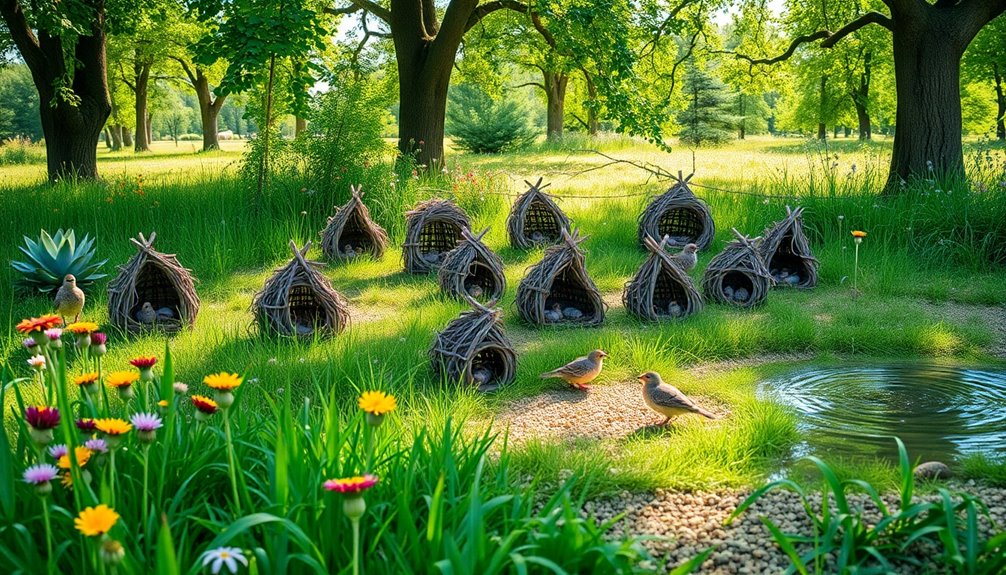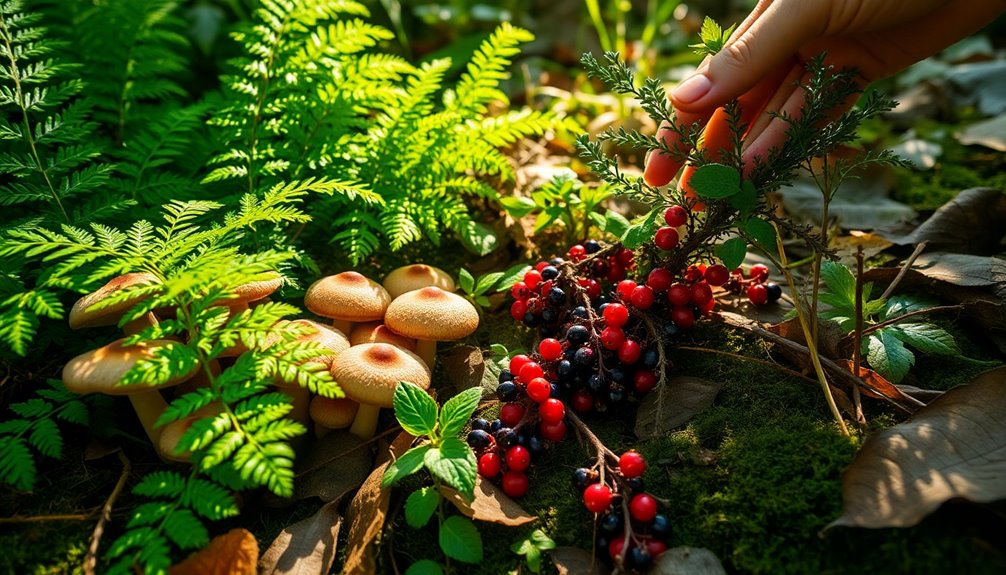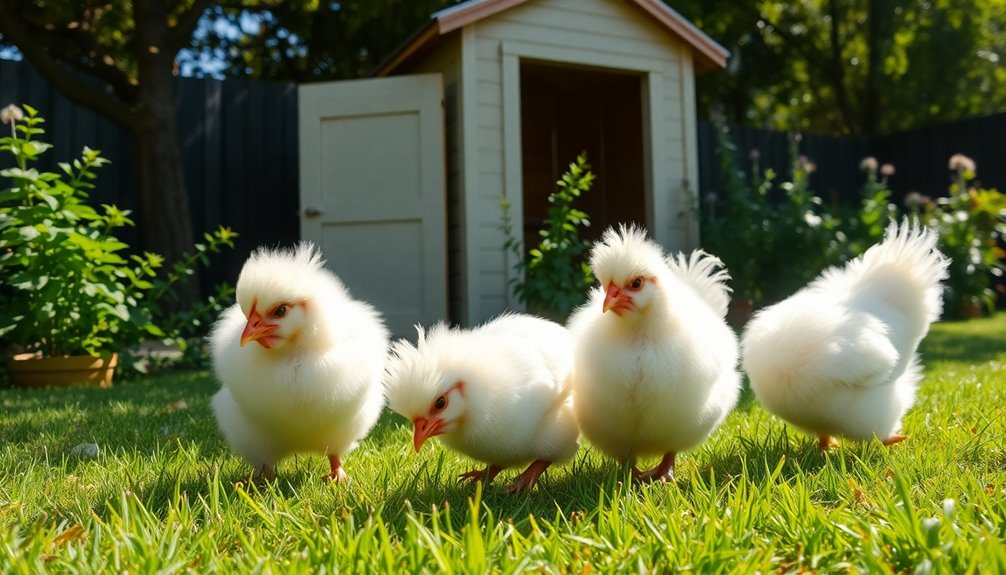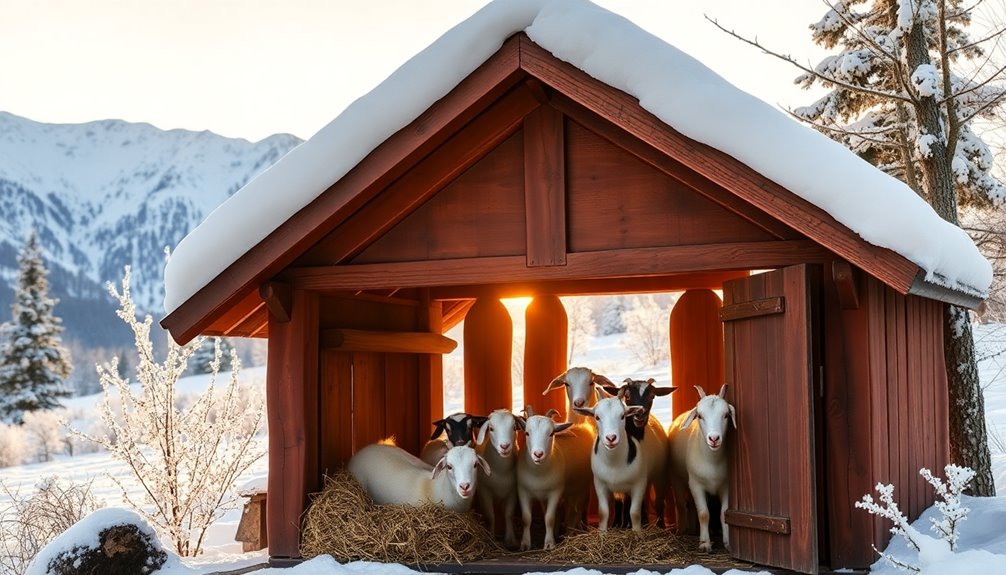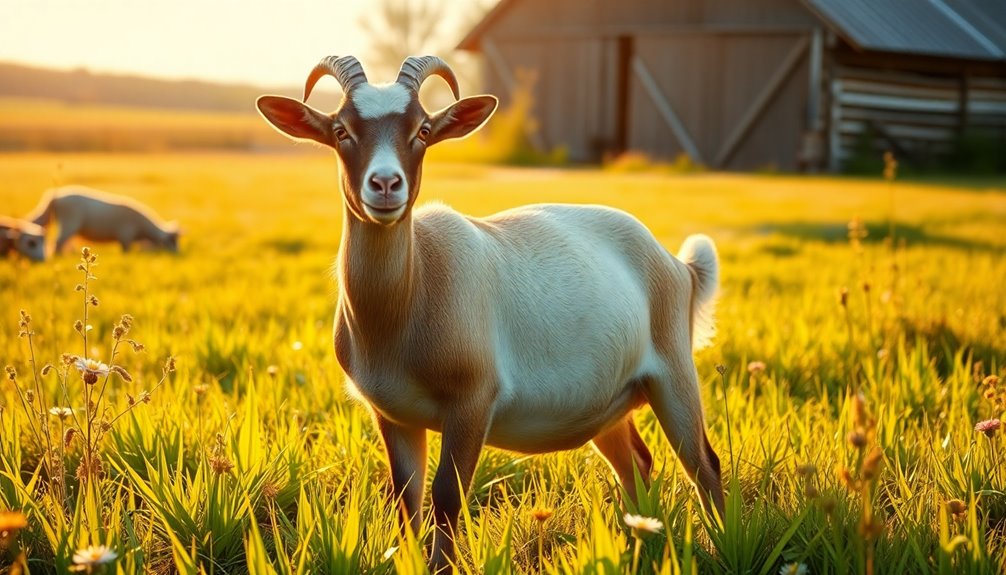To create the ideal quail habitat, start by securing at least 1 square foot per bird, ideally 3 square feet for comfort. Provide ample space for foraging and dust bathing, incorporating natural elements like shrubs for nesting. Include interactive toys and varied textures to stimulate their instincts. A balanced diet with greens, grains, and protein is essential, along with fresh water at all times. Maintain clean conditions to promote health and prevent disease. Finally, engaging with other quail keepers can offer valuable insights and tips for success. Discover the next steps for a thriving quail environment.
Key Takeaways
- Ensure a minimum of 3 sq ft per bird, adding 20-30% more space for activities like foraging and dust bathing.
- Create secure enclosures with top protection against predators and escapees.
- Incorporate natural elements like shrubs for nesting and varied textures for foraging to enhance their environment.
- Provide a balanced diet with grains, greens, and protein, along with constant access to fresh water.
- Engage with the quail-keeping community for shared knowledge, strategies, and updates on best practices.
Habitat Design and Site Selection
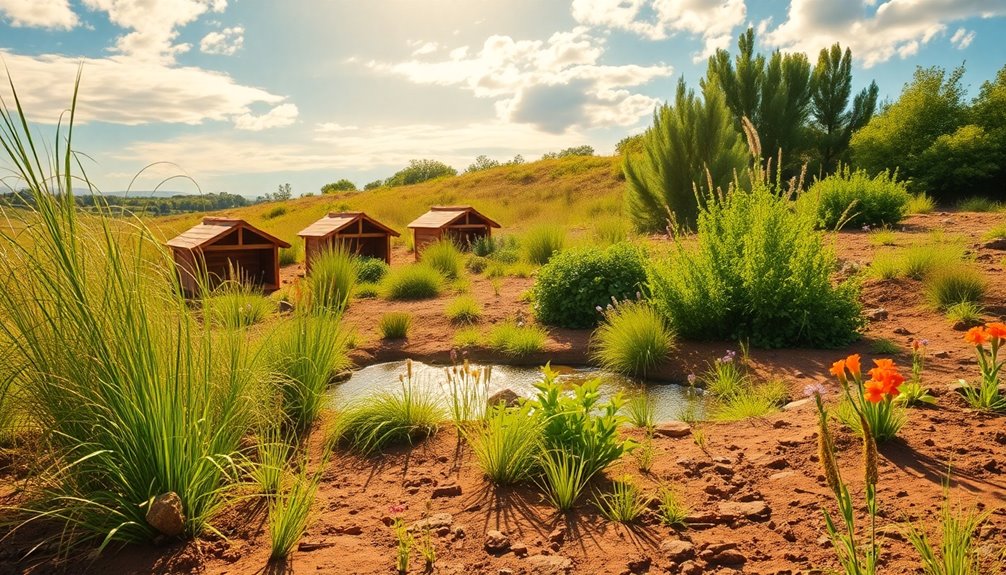
When designing a quail habitat, it's vital to guarantee each bird has enough space to thrive—at least 1 square foot for standard Coturnix and 1.5 square feet for Jumbo Coturnix. Evaluating their space needs is fundamental for their comfort and well-being.
A well-structured quail cage should include secure enclosures to protect your birds from predators, both aerial and ground. Incorporate features like a top cover and burrowing mesh around the perimeter to safeguard their safety.
To further enhance their habitat, consider adding natural elements like shrubs and grass to create inviting nesting areas. These additions not only provide comfort but also encourage instinctual behaviors, such as foraging.
Ventilation is another significant aspect; proper airflow helps prevent respiratory issues, especially in humid climates or during warmer seasons.
The layout of your quail habitat should allow birds to familiarize themselves with their surroundings, promoting better pair bonding and nesting behaviors. By thoughtfully addressing these design elements, you'll create a thriving environment that meets the needs of your quail while fostering a sense of security and comfort.
Natural Behaviours and Enrichment
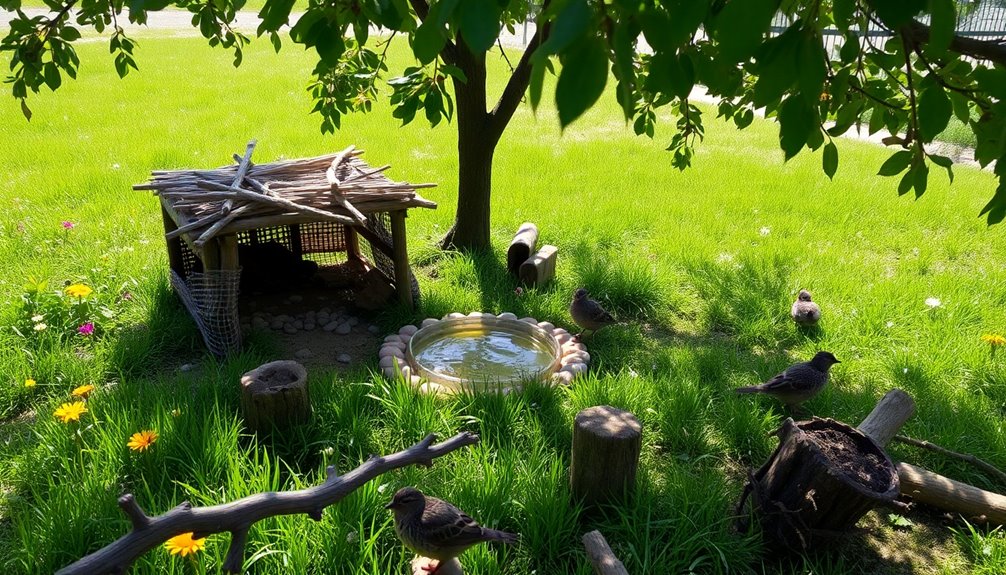
To create a thriving quail habitat, you need to focus on their natural behaviors and enrichment.
Providing foraging opportunities and social interactions is essential for their happiness and overall well-being.
Additionally, incorporating enrichment activities will stimulate their instincts and enhance their quality of life.
Natural Foraging Opportunities
How can you create a stimulating environment for quail that mirrors their natural foraging instincts? Start by incorporating various foraging materials that encourage exploration. Use a mix of textures and scents, like grass, leaves, and herbs. This variety not only engages their senses but also promotes their natural foraging behavior, keeping them mentally stimulated.
Consider adding interactive toys or feeders that require your quail to manipulate them to access food. These activities mimic the challenges quail face in the wild, making mealtime more engaging and reducing boredom.
You can also set up dust-bathing areas, vital for their feather maintenance, where quail can engage in natural behaviors while maintaining hygiene.
To keep the environment fresh and interesting, regularly change the layout of foraging materials or introduce new items. This creates habitat variability, which is essential for quail's mental and physical well-being.
Social Interaction Benefits
Creating a social environment for your quail is essential for their well-being. Quail thrive in flocks, and social interaction benefits them by enhancing happiness and reducing stress. When raising quail, it's important to provide additional space for them to roam and interact naturally.
Here's a quick look at how social behaviors impact your quail:
| Behavior | Benefit |
|---|---|
| Dust-bathing | Aids feather maintenance and social bonding |
| Nesting areas | Encourages exploration and pair bonding |
| Gentle handling | Builds trust and reduces fear |
By providing multiple nesting areas, you encourage exploration and strengthen their social structure. Interacting regularly with your quail can foster trust, creating a more positive environment for both you and your birds. Quail around each other exhibit natural behaviors that are vital for their reproductive success.
To sum it up, ensuring your quail have a social environment is an important thing that enriches their lives and keeps them mentally stimulated. So, consider these factors as you set up your quail habitat!
Enrichment Activities Essentials
Enrichment activities are essential for quail, as they mimic natural behaviors and keep your birds mentally stimulated. Start by providing a designated dust-bathing area filled with fine sand or dirt. This is important for their feather maintenance and overall health.
Incorporate natural elements like shrubs and grass within their habitat to enhance comfort and encourage exploration, allowing quail to exhibit instinctual behaviors.
Interactive toys, varied textures, and scented materials are excellent enrichment activities that stimulate their natural foraging instincts. Regularly handling your quail can also build trust and reduce fear, making them feel more comfortable in their environment, which boosts their overall happiness. Engaging with Waldorf toys can promote cognitive development in pets by encouraging play that mimics natural behaviors.
Don't forget that social structures are significant for quail. Keeping them in groups promotes happiness and reduces stress since they're inherently social animals.
Nutrition and Health Management
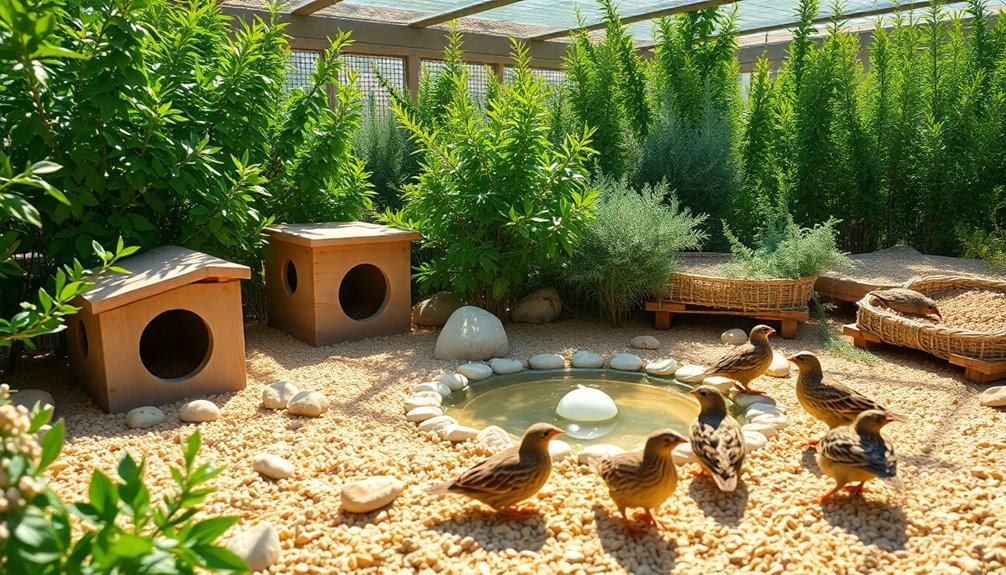
To maintain ideal health and productivity in quail, a well-balanced diet and proper health management are crucial. Start by providing a balanced diet rich in grains, greens, and protein.
Chicks need 20-30% protein, while adults require 20-25% to support peak health and egg production. Don't forget about fresh water—make sure it's available at all times, as dehydration can cause stress and health issues.
Incorporate calcium supplementation, like oyster shells, especially for laying females to improve egg production and strengthen eggshells.
Regular health checks are essential; monitor for any signs of stress or illness. Implement biosecurity measures to reduce pathogen exposure and prevent disease outbreaks.
Here are a few key practices to keep your quail thriving:
- Regularly clean habitats to minimize waste buildup.
- Make sure there's consistent access to fresh water.
- Conduct frequent health checks to catch issues early.
Design Criteria and Materials
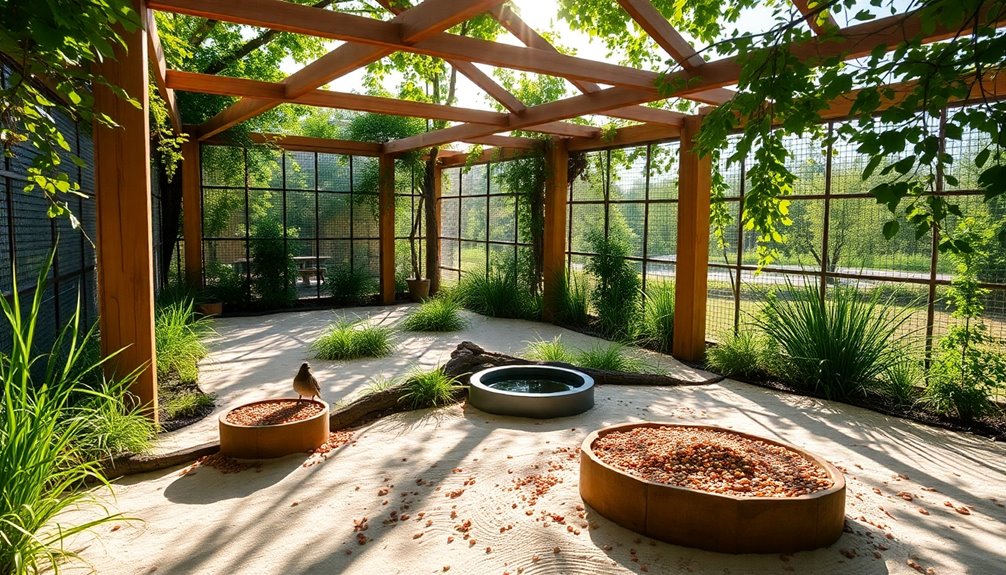
When designing a habitat for quail, it's essential to prioritize their comfort and safety. Start by providing at least 3 square feet of space per bird. This helps minimize stress and guarantees they thrive.
Your design should feature secure enclosures with a top to prevent escapes and protect against predators.
Consider using sustainable materials like double-paned windows and pallet wood, which maintain structural integrity while being environmentally friendly. Incorporate natural elements such as shrubs and grass to enhance their comfort and encourage natural behaviors like foraging and nesting.
For ventilation and added security, opt for UV-stabilized polythene and chicken wire. Additionally, bury mesh around the perimeter to deter any digging threats.
Your habitat's design should support year-round outdoor living, integrating planted environments that enrich the quail's health and well-being.
Space Requirements for Quail
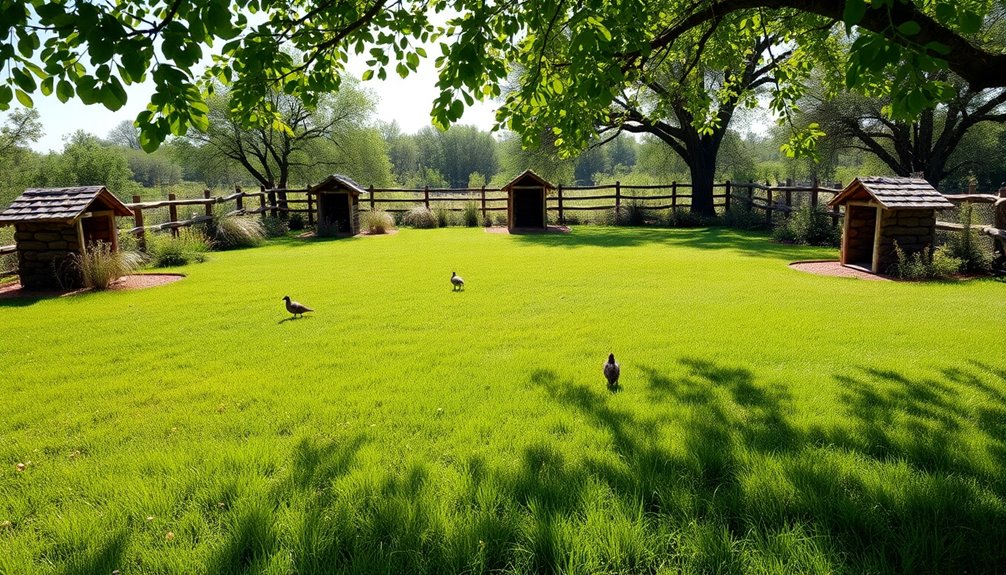
When it comes to quail, understanding their space requirements is essential for their health and happiness.
Each standard Coturnix quail needs at least 1 square foot, while Jumbo Coturnix require 1.5 square feet, so planning your space accordingly can prevent overcrowding and stress.
Always remember to factor in extra room for activities like foraging and dust bathing to create a thriving environment.
Minimum Space Guidelines
Providing adequate space for quail is essential for their well-being and comfort. Following the minimum space guidelines guarantees your feathered friends can thrive. For Standard Coturnix quail, you'll need at least 1 square foot per bird, while Jumbo Coturnix require 1.5 square feet each. Always aim for more than the minimum to prevent overcrowding and its negative effects.
Consider these important factors when planning their space:
- Room for movement: Quail need to stretch their wings and roam freely.
- Space for natural behaviors: Activities like foraging and dust bathing require additional space.
- Age and group size: Chicks need less space than adults, and larger flocks demand more room to reduce aggression.
To provide the best environment, it's recommended to add 20-30% more space for these natural behaviors.
For example, a flock of 12 Jumbo Coturnix quail would ideally need around 23.4 square feet when factoring in both the minimum space and additional room.
Overcrowding Impact Factors
Overcrowding can greatly impact the health and behavior of your quail. To guarantee your birds thrive, you must meet their space requirements. Standard Coturnix quail need at least 1 square foot per bird, while Jumbo Coturnix require 1.5 square feet.
If you have a flock, consider increasing the total space by 20-30% to allow for natural behaviors like foraging and dust bathing.
When quail are overcrowded, their stress levels can rise considerably. This stress can lead to aggressive behaviors and make them more susceptible to illness, which can compromise their overall health.
Additionally, as your quail grow, their space needs change. Chicks need less room than fully grown adults, so factor this into your planning.
The size of your flock also plays an essential role in determining space requirements. Larger groups need more space per bird to minimize competition for resources and maintain a healthy environment.
Community Engagement and Resources
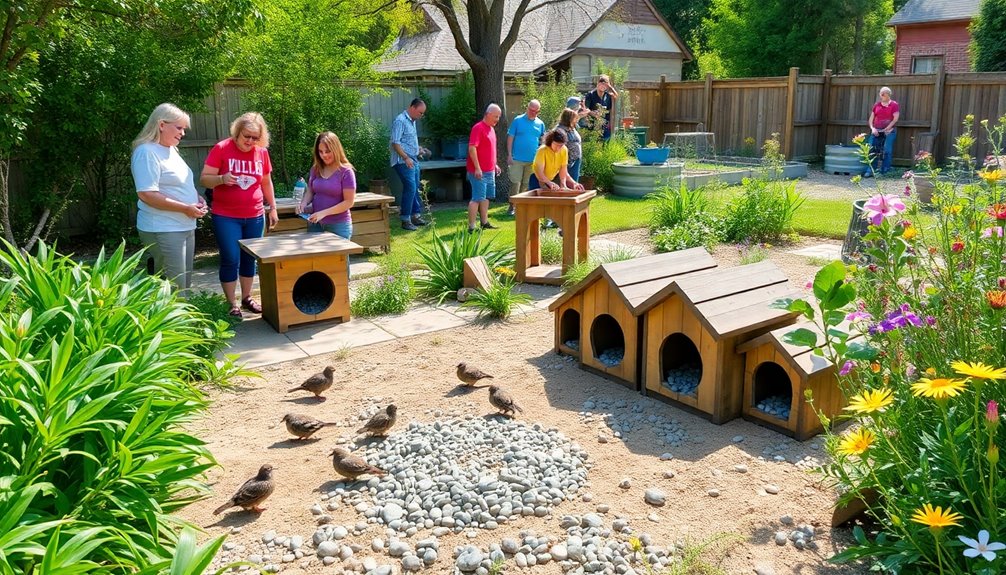
Engaging with the quail-keeping community can greatly enhance your experience and knowledge in raising these birds. By connecting with others through online forums and social media, you can access valuable resources and insights that make quail care easier and more rewarding.
Here are a few ways to immerse yourself in this supportive community:
- Share your experiences: Discuss your challenges and triumphs, and learn from others' journeys.
- Access expert advice: Benefit from tips and strategies shared by seasoned quail keepers, which can help you avoid common pitfalls.
- Stay updated: Follow blogs and newsletters to stay in the loop on the latest trends and innovations in quail management.
Participating in local groups or online forums dedicated to quail raising can foster collaborative discussions about best practices and solutions.
Don't hesitate to donate through platforms like PayPal or support creators on Patreon, as this helps maintain and expand community resources.
Frequently Asked Questions
How Do You Set up a Quail Habitat?
To set up a quail habitat, start by choosing a secure enclosure that offers at least 1 square foot per quail.
Add natural elements like shrubs for comfort and guarantee good ventilation.
Incorporate multi-level platforms for perching, along with dust-bathing areas and foraging spots to keep your quail mentally stimulated.
Regularly clean the space to prevent waste buildup, and consider using movable pens for easy maintenance and cleanliness.
What Is the Ideal Habitat for Quail?
The ideal habitat for quail combines security and comfort.
You'll want to provide at least 1 square foot for standard Coturnix and 1.5 for Jumbo.
Incorporate natural elements like shrubs and grass, along with dust-bathing areas for their well-being.
Guarantee good ventilation to prevent respiratory issues and protect against weather.
Regular maintenance is crucial to keep things clean, and adding vertical space can enhance their living conditions and encourage natural behaviors.
What Is the Ideal Housing for Quail?
To create ideal housing for quail, you need secure enclosures, adequate space, and proper ventilation.
You'll want to use wire mesh to protect against predators while allowing natural light in.
Make sure each quail has at least one square foot, or 1.5 for Jumbo Coturnix.
Incorporate deep bedding for waste management, provide shelter from harsh weather, and add natural elements to encourage foraging and nesting, ensuring their comfort and well-being.
What Is the Ideal Space for Quail?
To determine the ideal space for your quail, start by allocating at least 1 square foot per Standard Coturnix and 1.5 square feet for Jumbo Coturnix.
Consider adding 20-30% more space to prevent overcrowding and allow for natural behaviors like foraging and dust bathing.
Keep an eye on their behavior, adjusting their living area as needed, especially if you plan to expand your flock.
Happy quail means a thriving flock!
Conclusion
Creating the ideal quail habitat is a rewarding endeavor that not only supports their natural behaviors but also contributes to their health and well-being. Did you know that quails can lay up to 300 eggs a year? With the right design, nutrition, and community resources, you can foster a thriving environment for these fascinating birds. By understanding their needs and behaviors, you'll guarantee your quails lead happy, productive lives while enriching your own experience.

